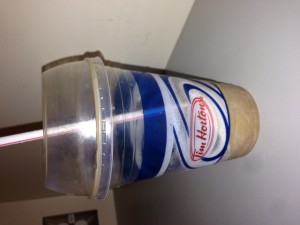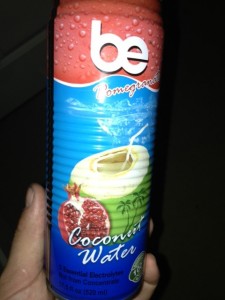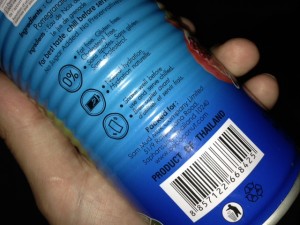For lunch I went to Tim Hortons on campus and ordered the following:
- Medium ice capp
- Large ham and Swiss on whole wheat bread
- Coconut donut



The ham and Swiss sandwich contained ham, Swiss cheese, lettuce, and tomato. Packaging included paper and waxed paper. The tomato and lettuce could be grown locally, or on the other side of the country. It is even possible that it was grown locally, shipped to Ontario, and then shipped back! It isn’t clear.
The ice capp came in a plastic cup with a plastic straw. The plastic straw had a paper wrapper. It presumably contained coffee made from coffee beans as well as cream and sugar. Thus there is direct petroleum used in the plastic packaging. Tim Horton’s uses a blend of beans that typically comes from a variety of South American countries (4). The coffee beans would have been shipped via cargo ship from South America and then truck within Canada. The cream and sugar was likely within Canada and required truck or rail transport to get to distributor. Sugar would be similar to the information quoted in my breakfast post.
The donut came in a paper bag and likely contains coconut, wheat, sugar, salt, milk, flour, margarine, and eggs. These products could be from a variety of places, but the coconut and sugar would be the most remote. The rest of the ingredients could likely have been produced within the Canadian prairies.
Tim Horton’s used to bake their donuts in house, but not they are baked at Maidstone Bakeries in Brantford, Ont (1). I was unable to find out if any supplies are sourced locally. From google maps I was able to determine that the trucks would have to drive about 4400 km between Brampton and Vancouver. Tim Horton’s has increased its fuel efficiency of its fleet vehicles by 9.2% since 2008 (2). I was unable to find any more detailed information about the exact fuel efficiency for their fleet. From this (3) fuel efficiency of semi trucks seems to vary between 4 and 9 mpg. Let’s use 6mpg as a rough estimate and assume that all goods are delivered from Ontario (like the donuts.) In km/l this is 2.55 km/l. This translates to 1724L of diesel to transport a full load across country.
Electricity, for the most part, in BC is hyroelectric. So the local restaurant itself did not contribute significantly to the oil consumed by the meal.
- http://www.thestar.com/business/2010/08/12/tim_hortons_plans_to_return_475_million_from_maidstone_sale_to_shareholders.html
- http://www.go-green.ae/greenstory_view.php?storyid=2294
- http://wiki.answers.com/Q/What_is_average_fuel_mileage_for_semi_trucks_in_the_U.S.A.
- http://makegoodcoffee.com/coffee-talk/where-does-tim-hortons-coffee-come-from/









